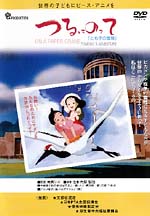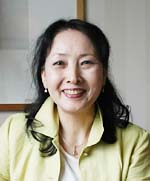"On a Paper Crane: Tomoko's Adventure" by Miho Cibot

|
Tomoko, a girl in the 6th grade of elementary school, visits Hiroshima Peace Memorial Park alone during summer vacation. She meets a girl named Sadako in front of the Children's Peace Monument. Learning about Sadako's experience as a young child, Tomoko rides on a crane with her and goes on an unexpected adventure which includes traveling around the world. This film, released in 1993, has been recommended for peace education studies by the Ministry of Education, Culture, Sports, Science and Technology, a nationwide conference of the Japanese PTA, and other bodies. |
Shocked by seeing a boy playing war
Peace education via a Japanese animated film

|
Miho Cibot
Born in Shizuoka prefecture in 1949. She moved to France in 1975. She founded "Institut Hiroshima Nagasaki (Hiroshima Nagasaki Research Institute)" in 1982. Now she is an adviser of Mayors for Peace France (AFCDRP). She is well-known as a poet. She received an award for her tanka by Asahi Shimbun newspaper (Asahi Kadan Award) in 2000.
In addition to a Japanese version, the animated film "On a Paper Crane" has an English version and a French version. It has been screened in more than 65 countries. Seventeen years have passed since the initial Japanese version was released, and the film is still being screened in nations around the world. Miho Cibot, 60, who conceived the original story for the film, smiled and said, "She keeps on flying."
Ms. Cibot is married to a Frenchman and lives in the city of Malakoff, near Paris. She began her peace activities about 30 years ago. She was taking care of a French boy, who was eight years old, and watched him "playing war." "Next we'll drop an atomic bomb!" he said. She became concerned that her own two boys would eventually play a similar game. "I came to feel I should teach my children about the atomic bombs," she recalled.
She came up with the idea of using an animated film for peace education in the mid-1980s as she felt spreading such information in France through lectures alone had limitations. Plus, most materials and films related to the atomic bombings are made for adults.
At the time, Japanese animated TV programs were very popular in France. French children loved such shows as "Astro Boy," "Flash Kicker," and "Dragon Ball" and about 80% of all animated programs on French TV were reportedly Japanese animation.
Ms. Cibot wanted to make use of the fun, high-quality nature of Japanese animation, so she was determined to produce the animated film in Japan. She made up the tale based on the story of Sadako Sasaki who experienced the atomic bombing when she was two years old and died of radiation-induced leukemia ten years later, and the raising of the Children's Peace Monument in her honor. She said, "I wanted to make a film that would be a symbol of hope. I didn't want the audience to simply feel sad. After seeing the film, I wanted them to feel inspired to tell others about the people who are striving for peace in the world."
The initial Japanese version of the film was released in 1993. Both the English and the French versions were produced in 1994. That same year a Japanese picture book was published, too. In the fall of 1994, the film was screened at United Nations Headquarters in New York.
Later, the United Nations Educational, Scientific and Cultural Organization (UNESCO) made a request of her, saying, "Children in Africa have little chance to watch films. Please create a radio drama." Ms. Cibot discussed the idea with NHK (Japan Broadcasting Corporation) and NHK made a radio drama in 2005 when Hiroshima observed the 60th anniversary of the atomic bombing. To date, the radio drama has been broadcast in 24 languages.
Ms. Cibot advises youth: "I'd like you to watch and listen to the world around you. As you do this, the answer to what you should do will come clear in a flash." She added: "When I was young, many older people supported my peace activities. I would like to offer the same sort of help to young people who are making efforts for peace." (Rie Nii, Staff Writer)
|